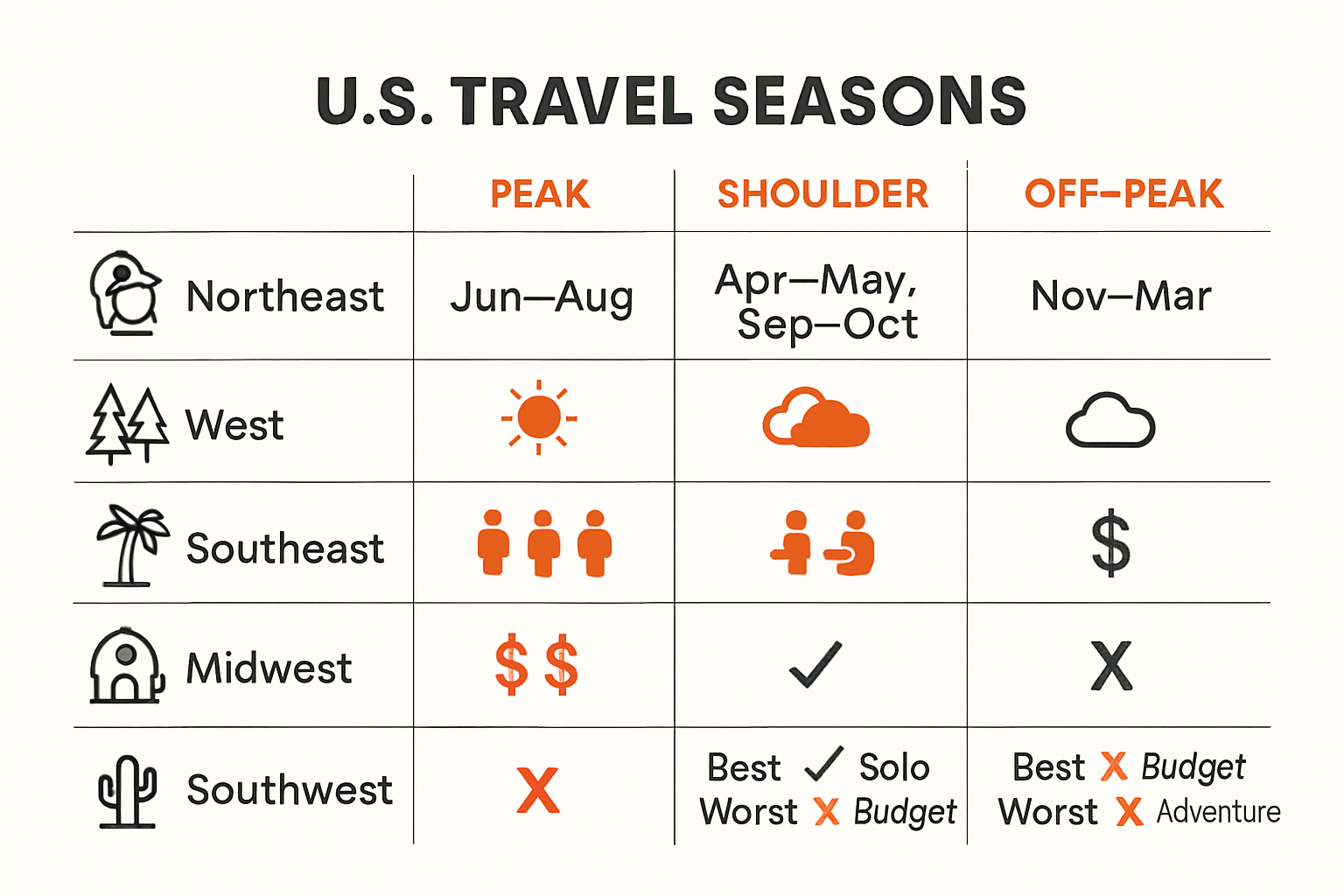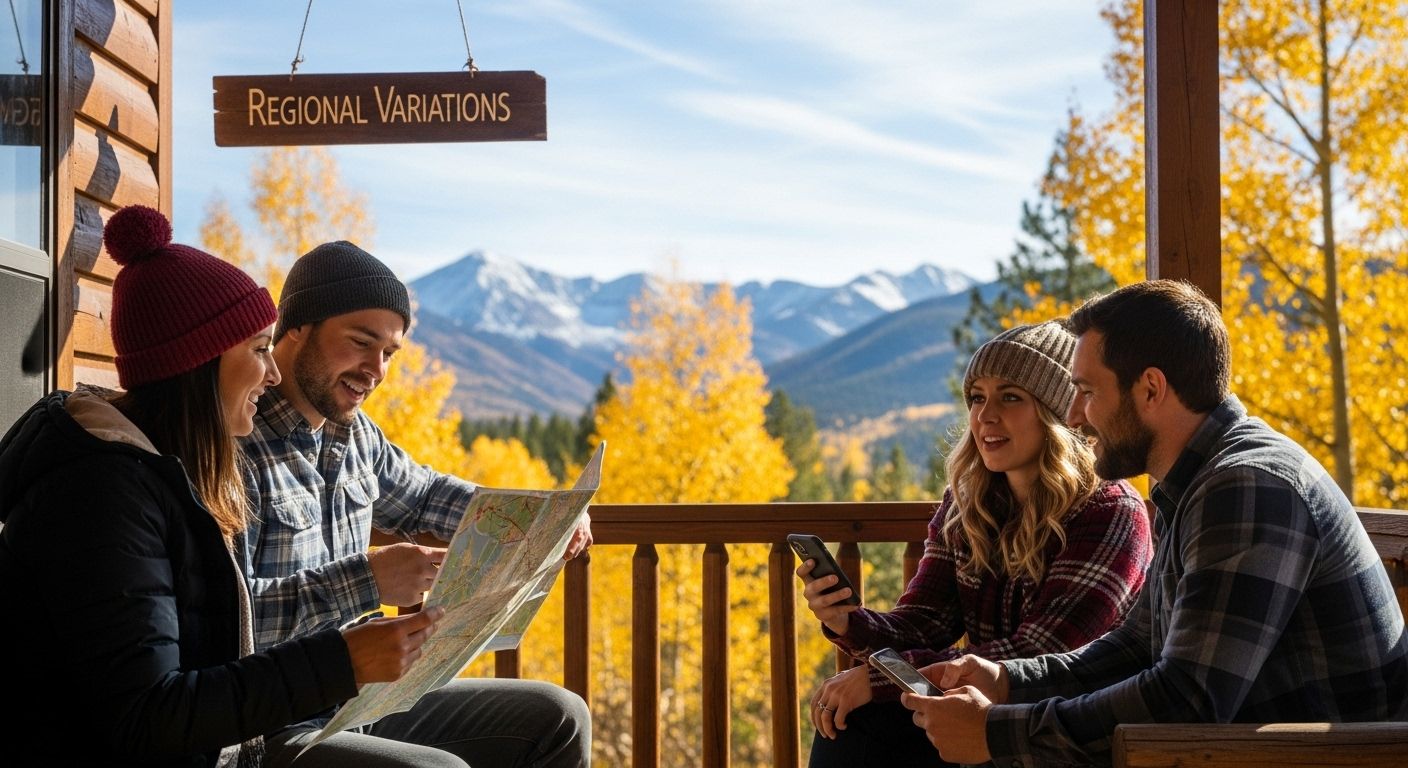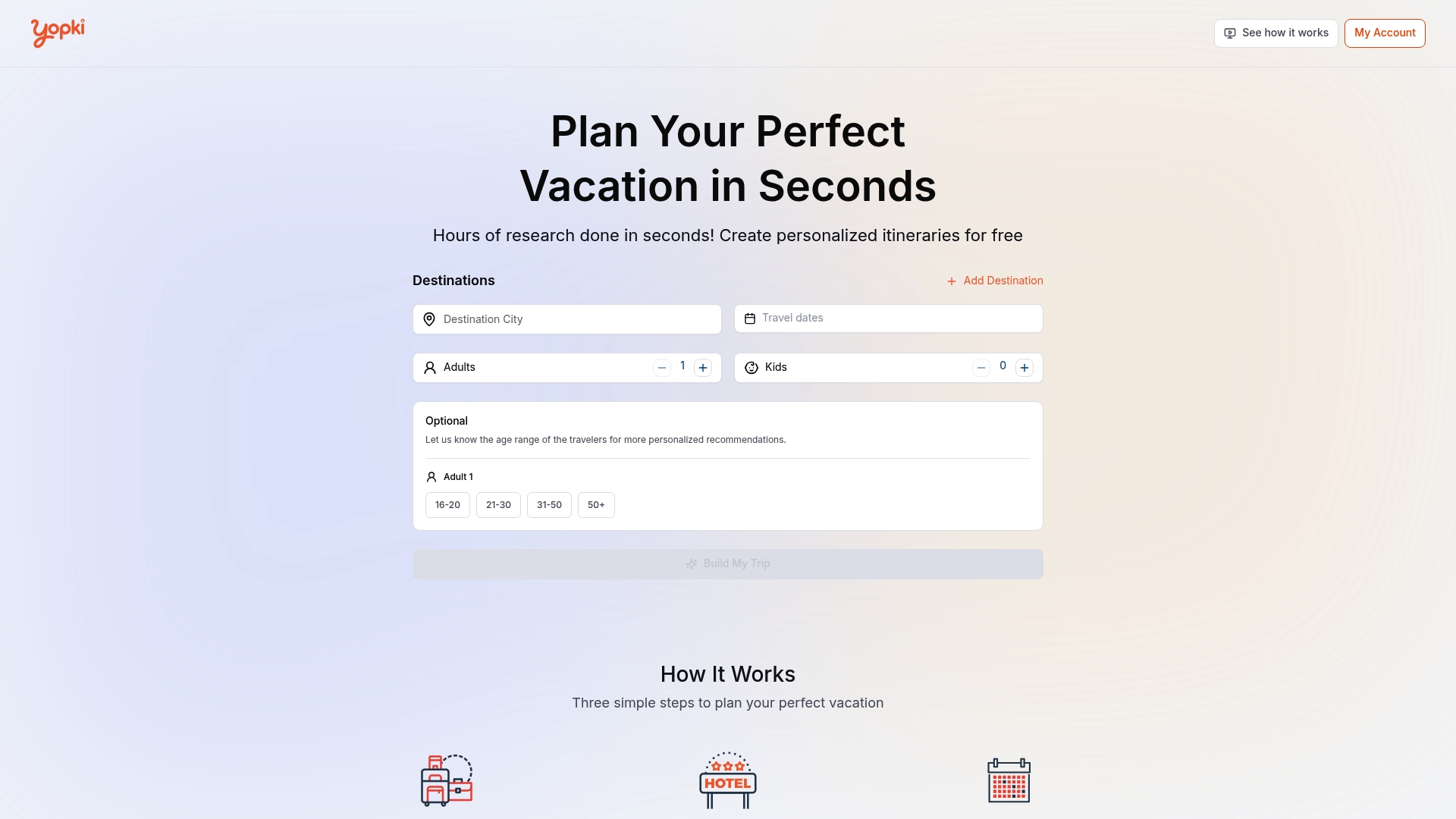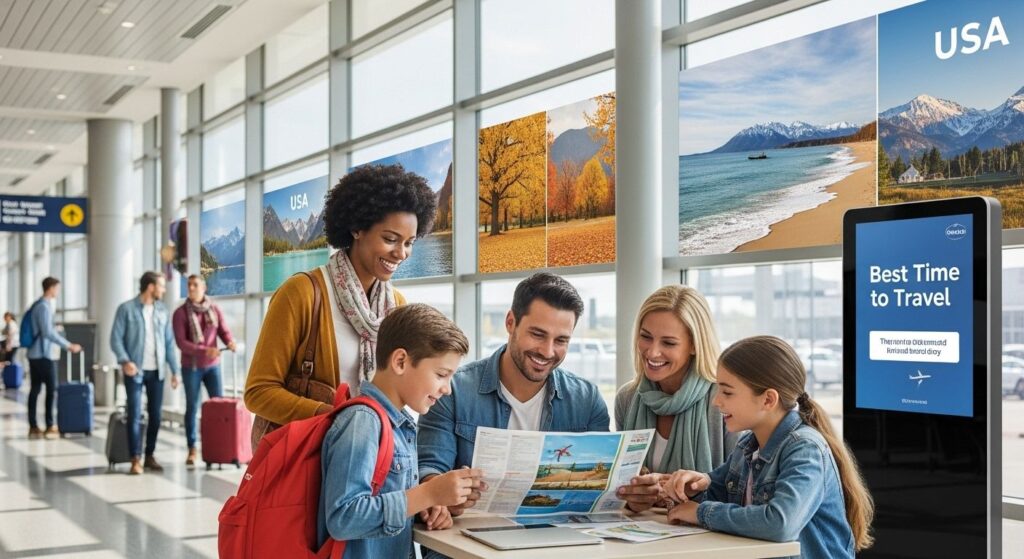Travel season in the United States is more than just sunny days and crowded beaches. During summer, 84 percent of trips are for leisure and tourism explodes with millions crisscrossing the country. That sounds hectic and expensive, right? What most people miss is that the best travel moments often come when crowds are gone and prices quietly drop nearly in half.
Table of Contents
- The Concept Of Travel Seasons In The Usa
- Impact Of Climate And Weather On Travel Timing
- Regional Variations: When To Visit Major Destinations
- Understanding Events And Holidays That Influence Travel
- Economic Factors: Budgeting Your Travel Time
Quick Summary
| Takeaway | Explanation |
|---|---|
| Travel seasons shape experiences | Understanding peak, shoulder, and off-peak seasons can enhance your trip’s enjoyment. |
| Research regional variations | Different regions have unique travel windows, impacting comfort and accessibility. |
| Consider climate effects | Climate factors like temperature and precipitation influence travel timing and comfort levels. |
| Plan around holidays | Major national holidays can affect travel costs and accessibility, requiring advanced planning. |
| Budget for seasonal pricing | Travel costs vary significantly; off-peak travel can save 30-50% on accommodations. |
The Concept of Travel Seasons in the USA
Understanding travel seasons is crucial for planning an optimal trip across the United States. Travel seasons represent distinct periods characterized by specific weather patterns, tourism trends, and traveler experiences that significantly impact your journey. Learn more about seasonal travel planning.

Peak vs. Off Peak Seasons
The United States experiences four primary travel seasons: peak season, shoulder season, off-peak season, and low season. Peak season typically occurs during summer months (June through August) when most destinations experience maximum visitor traffic. During this period, attractions are fully operational, weather is most favorable, and tourist infrastructure is at its most robust.
To help you understand how different travel seasons affect your experience and costs, here is a comparison of the four major travel seasons in the USA.
| Travel Season | Months (Typical) | Key Characteristics | Cost Implications |
|---|---|---|---|
| Peak Season | June – August | Highest visitor traffic, fully operational attractions, favorable weather | Highest prices, limited availability |
| Shoulder Season | April – May, Sept – Oct | Fewer crowds, pleasant weather, some attractions less crowded | Moderate prices, more options |
| Off-Peak Season | November – March (non-holiday) | Least crowded, limited operations in some areas, unique experiences | Lowest prices, greater savings |
| Low Season | Varies regionally | Minimal tourism, potential weather challenges | Deep discounts, greatest flexibility |
According to national travel surveys, summer trips demonstrate distinctive characteristics:
- 21% of annual trips are dedicated to vacation or sightseeing
- 84% of summer travel is for leisure purposes
- Higher temperatures and longer daylight hours enable more extensive travel experiences
Regional Seasonal Variations
Travel seasons vary dramatically across different U.S. regions. The Southwest experiences intense heat during summer, making spring and fall more comfortable for exploring. Mountain regions like Colorado and Wyoming have shorter peak seasons due to alpine conditions, while coastal destinations like Florida maintain longer tourism windows.
Here is a summary table outlining how regional climates and seasonal factors impact the best times to visit major U.S. destinations.
| Region | Optimal Travel Season | Climate/Weather Considerations | Special Attractions |
|---|---|---|---|
| Northeast | Autumn (Sept-Oct), Summer | Fall foliage, cold winters, mild summers | Leaf peeping, coastal trips |
| Southeast/Gulf | Spring, Fall | Hot, humid summers, hurricane season (Jun-Nov) | Beaches, festivals |
| Southwest | Spring, Fall | Intense summer heat, mild winters | Desert landscapes, culture |
| Mountain States | Summer, Winter (for skiing) | Cold snowy winters, short summer window | Skiing, national parks |
| West Coast | Year-round | Mild, variable microclimates | Beaches, city breaks |
| Alaska | Summer (June-August) | Short summer season, extreme winter cold | Wilderness, wildlife viewing |
| Hawaii | Year-round | Warm, tropical, consistent weather | Beaches, volcanoes |
Regional differences mean travelers must research specific destination characteristics. Alaska, for instance, has an extremely short tourism season from June to August, while Hawaii offers year-round travel opportunities. Understanding these nuanced regional variations helps travelers select optimal times for their specific destination.
Climate change is progressively extending traditional travel seasons. Research indicates that warming temperatures are expanding visitation periods in national parks and creating more flexible travel windows across multiple regions.
Impact of Climate and Weather on Travel Timing
Climate and weather play pivotal roles in determining the optimal timing for travel across the United States. These environmental factors directly influence travel experiences, comfort levels, and accessibility to various destinations. Explore our comprehensive travel planning resources.
Temperature and Seasonal Patterns
Each U.S. region experiences unique temperature ranges that dramatically impact travel conditions. The Southwest desert regions can reach temperatures exceeding 110 degrees Fahrenheit during summer, making travel challenging and potentially dangerous. Conversely, mountain regions like Colorado experience significant temperature variations, with winter temperatures dropping well below freezing and creating specialized travel requirements.
Travelers must consider temperature ranges when planning their trips:
- Northern states experience more extreme winter conditions
- Coastal regions have more moderate temperature transitions
- Tropical destinations like Hawaii maintain consistent warm temperatures year-round
Precipitation and Travel Accessibility
Rainfall and precipitation patterns significantly influence travel planning. The Pacific Northwest experiences consistent rainfall during winter months, potentially limiting outdoor activities. Hurricane season in the Southeast and Gulf Coast regions creates additional travel considerations from June through November, with potential disruptions to transportation and tourism infrastructure.
According to climate research, precipitation patterns have become increasingly unpredictable, requiring travelers to maintain flexible itineraries and comprehensive travel insurance.
Understanding these climatic nuances allows travelers to make informed decisions about destination selection and travel timing. Weather considerations extend beyond mere comfort, impacting safety, accessibility, and overall travel experience across the diverse landscapes of the United States.
Regional Variations: When to Visit Major Destinations
The United States offers diverse travel experiences across different regions, each with unique optimal visiting periods that maximize traveler enjoyment. Check out our recommended travel timelines to plan your perfect trip.
Northeast Region Travel Considerations
The Northeast presents travelers with distinctive seasonal experiences. During autumn, states like Vermont, New Hampshire, and Massachusetts showcase spectacular foliage transformations, attracting millions of visitors between September and October. Winter offers exceptional skiing opportunities in mountain regions like the Adirondacks and White Mountains, while summer provides pleasant coastal experiences in destinations like Maine and Massachusetts.
Travelers should consider these regional nuances:
- Peak foliage season occurs from mid-September to early October
- Coastal regions offer comfortable temperatures from June to August
- Winter sports enthusiasts should plan trips between December and March
Western Destinations and Optimal Timing
Western states present dramatically different travel windows depending on specific locations. California offers year-round travel opportunities, with coastal regions providing mild temperatures throughout the year. National parks like Yosemite and Yellowstone have distinct visitation periods, typically concentrated during summer months when mountain passes are clear and hiking trails are accessible.
According to national climate research, understanding regional microclimates is crucial for planning successful trips. Mountain regions in Colorado and Utah experience significant temperature variations, with winter temperatures dropping substantially and creating specialized travel requirements.
The Southwest, including states like Arizona and New Mexico, presents unique travel challenges. Summer temperatures can exceed 100 degrees Fahrenheit, making spring and fall significantly more comfortable for exploring desert landscapes and cultural destinations. Understanding these regional variations allows travelers to optimize their experiences and avoid potential weather-related disruptions.

Understanding Events and Holidays that Influence Travel
Events and holidays dramatically reshape travel dynamics across the United States, creating unique opportunities and challenges for travelers. Plan your trip around key national events to maximize your travel experience.
National Holiday Travel Patterns
Major national holidays significantly impact travel volumes and destination accessibility. Thanksgiving, Christmas, and Independence Day represent peak travel periods where transportation infrastructure experiences maximum strain. These holidays create substantial travel demand, with millions of Americans simultaneously planning trips across different regions.
Travelers should anticipate these critical holiday travel considerations:
- Peak travel periods occur during late November, December, and early July
- Transportation costs increase by 20-40% during holiday windows
- Advanced booking becomes essential to secure accommodations
Regional Festivals and Cultural Events
Beyond national holidays, regional festivals offer unique travel experiences. New Orleans hosts its famous Mardi Gras celebration attracting over 1.4 million visitors annually, while Colorado’s ski resorts feature winter sports competitions drawing international audiences. Each event transforms local tourism landscapes, creating specialized travel windows with distinct characteristics.
According to transportation research, strategic planning can help travelers navigate complex holiday travel environments. The U.S. Department of Transportation has implemented measures to enhance travel efficiency during peak periods, introducing new direct routes and optimizing airspace management.
Understanding these event-driven travel dynamics allows travelers to make informed decisions, balancing potential crowd levels, pricing fluctuations, and unique cultural experiences across different U.S. destinations.
Economic Factors: Budgeting Your Travel Time
Travel budgeting involves strategic planning that extends beyond simple cost calculations, requiring travelers to understand complex economic dynamics across different U.S. regions. Discover smart travel savings strategies to maximize your travel experience.
Seasonal Price Fluctuations
Tourism pricing demonstrates significant variability depending on destination and time of year. Major metropolitan areas and popular tourist destinations experience dramatic price shifts during peak and off-peak seasons. Urban centers like New York and San Francisco typically maintain higher baseline costs, while smaller regional destinations offer more affordable travel windows.
Travelers should consider these critical economic considerations:
- Summer and holiday periods represent peak pricing windows
- Off-season travel can reduce accommodation costs by 30-50%
- Midweek travel often provides cheaper flight and hotel rates
Regional Economic Variations
Economic conditions vary dramatically across different U.S. regions, impacting travel expenses. Southern and Midwestern states generally offer more affordable travel experiences compared to coastal metropolitan areas. Rural destinations frequently provide more budget-friendly options, with lower accommodation and dining costs.
According to economic tourism research, understanding regional economic landscapes helps travelers make informed budgeting decisions. Transportation costs, local tax rates, and regional economic conditions significantly influence overall travel expenses.
Successful travel budgeting requires flexible planning, comprehensive research, and an understanding of how economic factors intersect with seasonal travel patterns. Savvy travelers can optimize their experiences by strategically selecting destinations and travel periods that align with their financial constraints.
Take the Guesswork Out of Planning the Best Time to Travel
If you have ever felt overwhelmed by confusing travel seasons, unpredictable weather, or endless research, you are not alone. This article has shown how the best time to travel in the USA depends on regional weather, events, and shifting prices. Trying to piece it all together can be stressful and exhausting.
Yopki solves this exact problem by making travel planning easy and personal. No more spreadsheets. No more second-guessing regional climate or holiday crowds. With Yopki, you instantly get a smart itinerary tailored to your interests, organized visually on a map, and synced with real-time weather and local events. You can rearrange your trip with simple drag-and-drop features and access all your tickets and reservations in one place. If you love the idea of a trip that adjusts to the seasons and your schedule, explore how Yopki can help you avoid typical travel headaches on our main website. For more inspiration on seasonal travel, check out our tips on the best times to visit the USA and how to create a perfect itinerary before you book your next adventure.

For a limited time, let Yopki turn complex seasonal details into a simple, enjoyable travel plan. Visit https://yopki.com now and see how easy and rewarding your next trip can be.
Frequently Asked Questions
What are the peak travel seasons in the USA?
Peak travel seasons in the USA typically occur during the summer months (June to August) and around major holidays like Thanksgiving and Christmas, when tourist traffic is at its highest.
How do regional climates affect the best time to visit the USA?
Regional climates significantly impact travel timing, as places like the Southwest can be extremely hot in summer, while the Northeast offers beautiful fall foliage and great skiing in winter. Researching specific regions is crucial for optimal planning.
How do I plan my trip around holidays and events in the USA?
To plan your trip around holidays and events, be aware of peak travel periods like Thanksgiving and Independence Day, when transportation can be crowded, and prices may surge. Checking local event calendars can help you experience local culture while avoiding excessive crowds.
What economic factors should I consider when timing my travel?
Economic factors such as seasonal price fluctuations can greatly affect your travel budget. Traveling during off-peak seasons can reduce costs by 30-50%, and midweek travel often offers cheaper rates for flights and accommodations.



